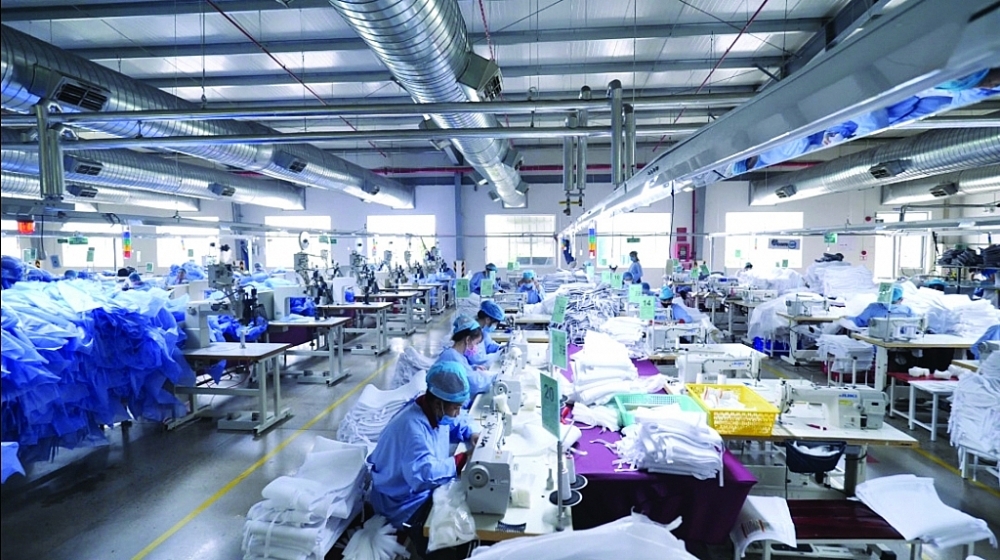 |
| Supply chain disruptions and a lack of raw materials for production mean many businesses now have to operate in moderation, only about 70 to 80% of factory capacity. Photo: T.D |
Businesses in trouble
According to the assessment of the Ministry of Industry and Trade, the ability to participate in regional and global value chains of Vietnamese industrial products is still very limited, mainly involved in processing and assembly with low added value.
Currently, Vietnam imports most of the input materials for key export industries such as textiles, footwear, electronics, etc., so it is greatly influenced by world markets. Or for the wood industry, Russia and Ukraine are two large supply markets for birch, beech, and pine wood to Vietnam, but the supply is currently congested.
Accordingly, many businesses are forced to find supplies from new markets such as Japan and Korea with prices 15%-20% higher, making businesses unprofitable and products difficult to compete in terms of price compared to other countries.
For example, with textiles, Pham Xuan Hong, Chairman of the Ho Chi Minh City Textile and Apparel Association, said that although the production of many textile and garment enterprises is quite positive, the order has been signed until the end of the third quarter of 2022, but the supply of raw materials and accessories is interrupted. The stage makes businesses hesitant to expand production. In addition to the increased pressure of input costs, businesses also have to calculate more radically.
Currently, the group of raw materials and accessories for the textile and garment and footwear industries imported into Vietnam mainly originate from China, accounting for about 50-52%. Meanwhile, China’s strong anti-Covid measures make it difficult to import raw materials. Many partners are not only short on delivery, but also have a longer delivery time due to the difficulty of finding alternative sources of raw materials.
According to Nguyen Quoc Anh, Chairman of Ho Chi Minh City Rubber – Plastic Association, Director of Duc Minh Rubber Co., Ltd., over 70% of raw materials, especially chemicals in Vietnam’s rubber plastic industry, depend mainly on imports from China.
However, the supply from this market is being blocked due to the implementation of “Zero Covid” policy by the Chinese side. In case the supply from this market continues to be interrupted, businesses are forced to import from Japan and Korea at 15-20% higher prices. With this price of input materials, enterprises are at risk of not being profitable and their products cannot compete in the world market.
Notably, the wood industry is currently facing many difficulties, leading to a decrease in production and export, including a scarce supply of raw materials and high prices.
Nguyen Liem, Chairman of Binh Duong Wood Processing Association, said that the production and business situation of wood enterprises is under a lot of influence from the world market. Countries tighten credit policies, inflation tends to increase, leading to a sharp decrease in consumer demand and no positive signal for the end of 2022.
Key export markets such as the US and Europe have seen a decrease in export orders. In addition, the price of raw materials for production and transportation also increased sharply, leading to the situation that many factories had to reduce production and cut workers.
Solving the problem of resource autonomy
Supply chain disruptions and a lack of raw materials for production mean many businesses now have to operate in moderation, only about 70 to 80% of factory capacity. Many businesses are now facing the risk of capital loss and contract compensation due to high production costs.
Facing these challenges requires businesses to minimize costs, apply science and technology, and expand import markets. The investment in raw materials from the country is also the solution that businesses are aiming for.
This will help save production costs as well as transportation costs, and thus product costs will be greatly reduced. Nguyen Tri Kien, General Director of Minh Tien Handbag Garment Company (Miti) said that taking the initiative in raw materials in Vietnam will greatly reduce costs, and cut waiting and transportation costs.
Binh Duong has focused on developing and forming industries producing raw materials for the textile industry (fiber production, weaving, zipper, dyeing, finishing textile products), mechanical industry (production of metal, production of metal products, production of machinery, equipment and spare parts for the automotive industry); electricity – electronics industry (production of electronic components, production of electrical wiring equipment, optical cables). Thereby, improving the localization rate for industrial products and reducing dependence on imported raw materials export.
To prioritize the development of supporting industries, Binh Duong has established an Industrial Park (IZ) in Bau Bang district with a scale of over 1,000 hectares, giving priority to attracting investment capital in supporting industries, especially foreign investment projects.
Up to now, there have been many supporting industry projects from major corporations in the world implemented in this industrial park. Typically, the project of a factory to produce tires and airbags for cars with an investment of up to US$1 billion of Kolon Group (Korea), in order to provide raw materials for the automobile manufacturing industry, or the project of a factory specializing in the production of aseptic packaging from paper, plastic and aluminum for food packaging of Tetra Park Binh Duong Joint Stock Company (Singapore), with registered investment capital of US$124 million in VSIP Industrial Park II.
For the timber industry, Dong Nai is developing a strategy of being more self-sufficient in raw materials, however, the source of locally planted forest wood is still modest. Dong Nai Wood and Handicraft Association as well as its member businesses are making efforts to coordinate with localities inside and outside the province to build sustainable raw material forests with the sustainable Forest Product Production and Processing Project until 2025, with an orientation to 2030.
